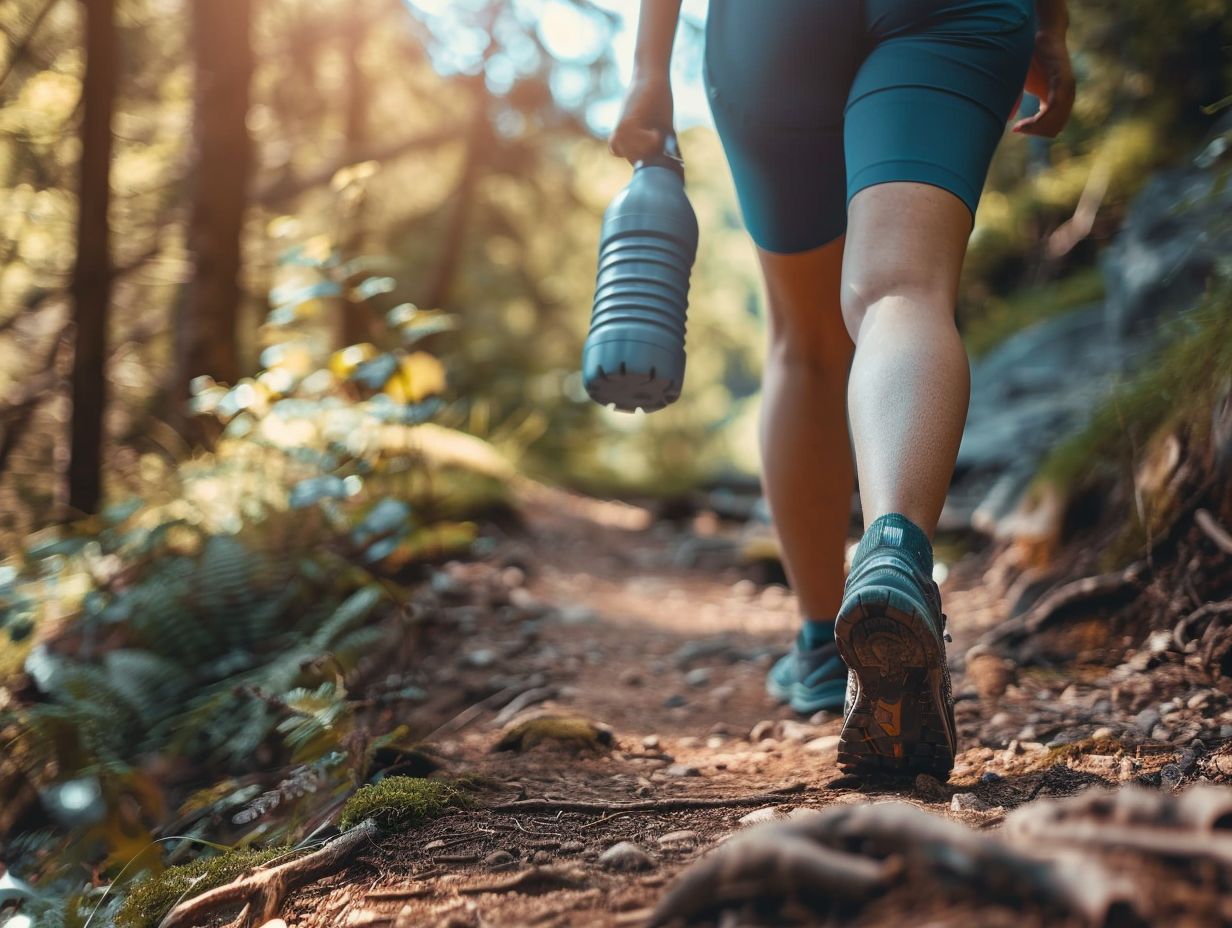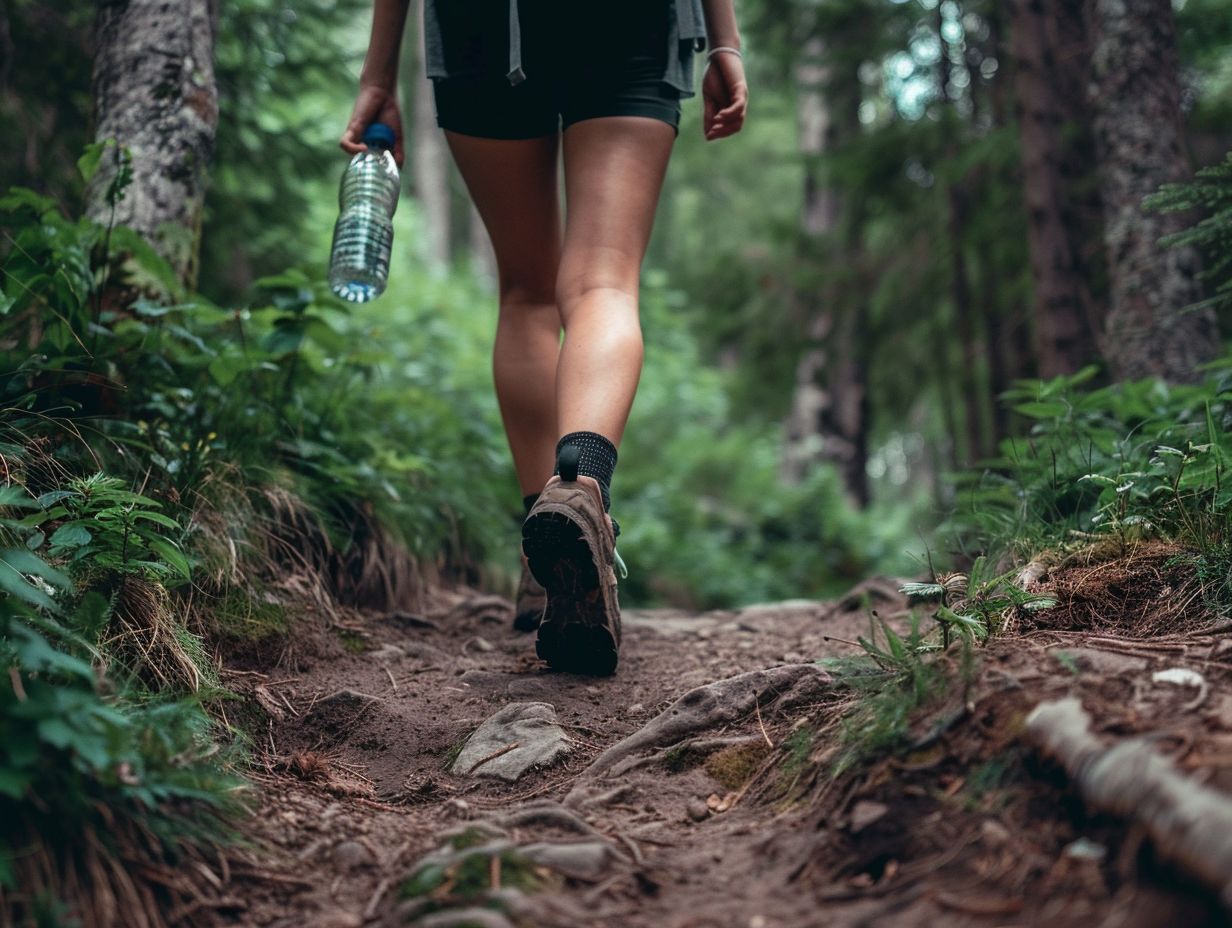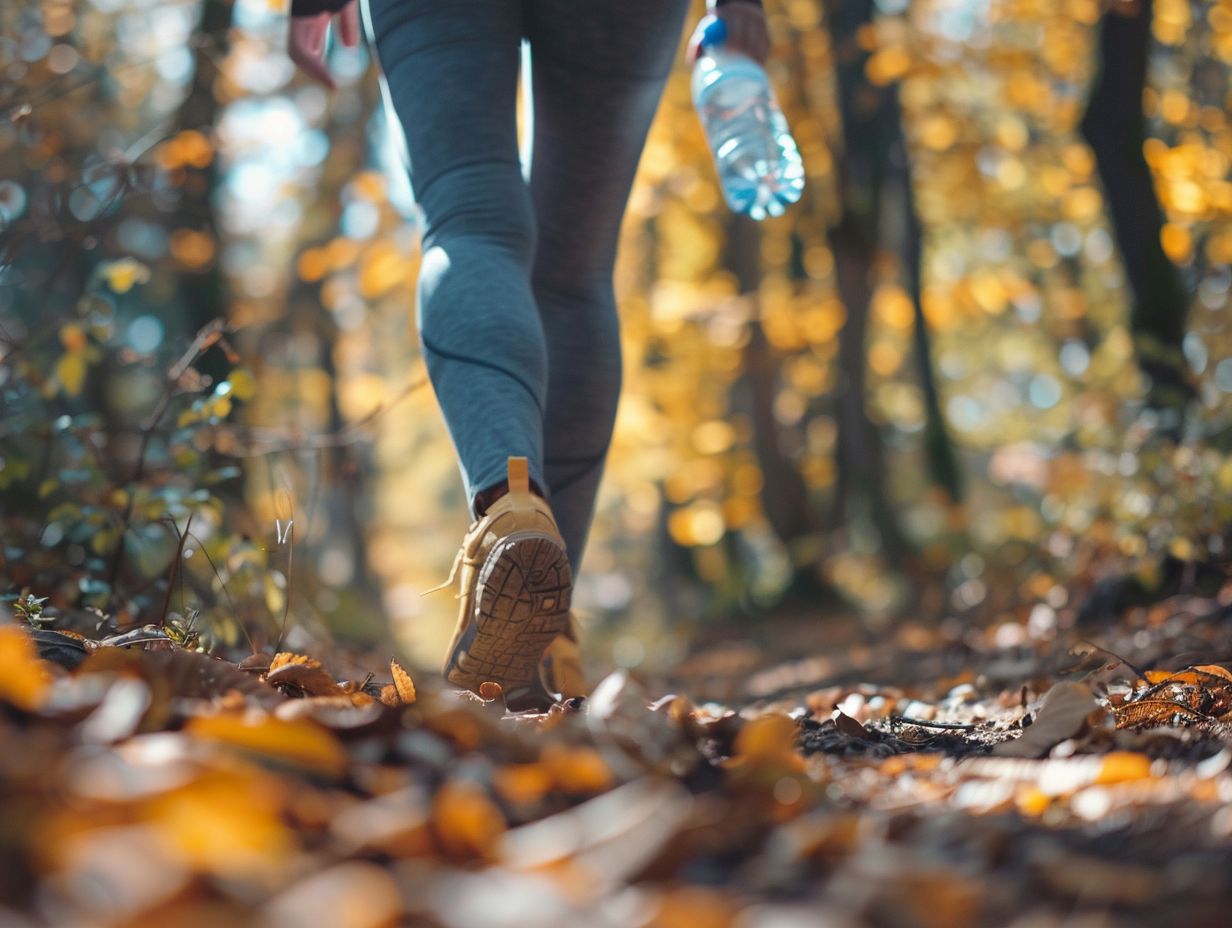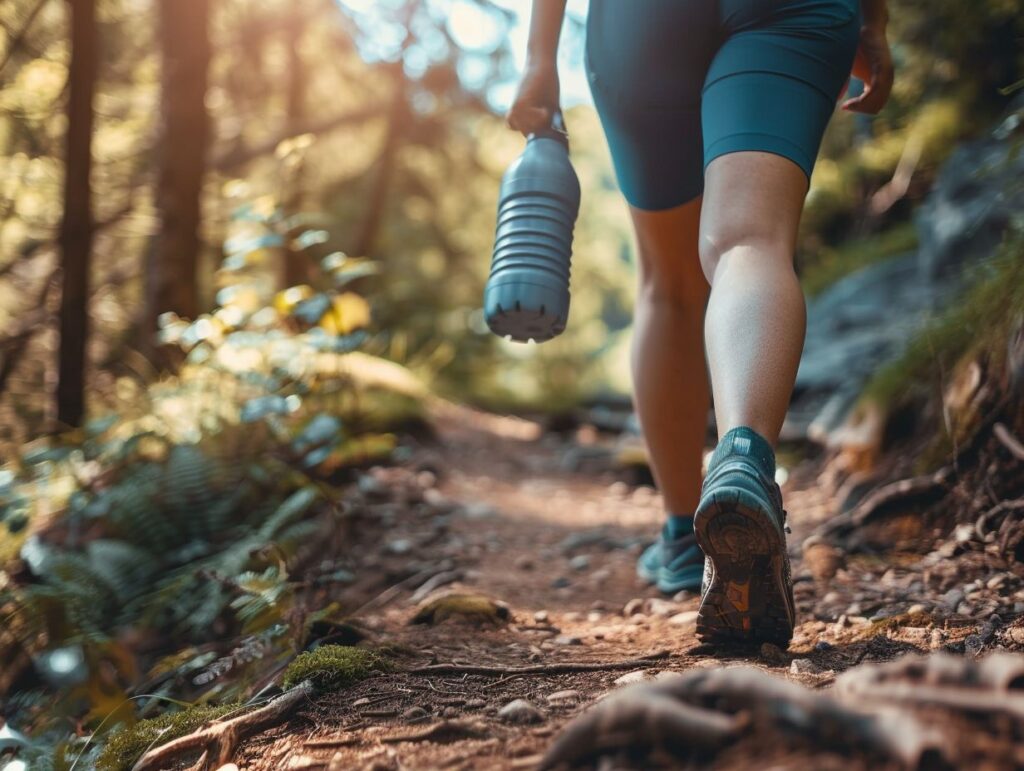Staying hydrated during a hike is crucial for your overall health and well-being. We discuss the signs of dehydration to watch out for and offer practical tips on how to stay hydrated on the trail.
From using a hydration pack to monitoring your urine color, we’ve got you covered. Additionally, we share some helpful tips for staying hydrated in hot weather.
Lace up your hiking boots and let’s dive in!
Key Takeaways:

- Staying hydrated during a hike is crucial for your health and safety.
- The amount of water you need on a hike depends on various factors like duration, intensity, and weather.
- Signs of dehydration can range from feeling thirsty to experiencing severe symptoms like dizziness and confusion.
How Can You Stay Hydrated During a Hike?
Maintaining sufficient hydration levels while participating in a hiking activity requires a comprehensive approach that involves regular consumption of water, using effective hydration containers, and ensuring the presence of a reliable water source.
1. Drink Water Before You Start
Consuming water prior to hiking is essential for ensuring proper hydration and establishing a solid basis for maintaining fluid levels during the entirety of your trail activity. Pre-hydration is a critical component in priming your body for the physical exertion associated with hiking.
By consuming a sufficient quantity of water before setting out on your hike, you can mitigate the risk of premature dehydration, which can result in fatigue, muscle cramps, and diminished performance. Health professionals recommend the intake of at least 16-20 ounces of water within the 1-2 hours preceding the commencement of your hike to optimise hydration levels.
This practice serves to not only sustain an ideal fluid balance but also amplify your overall endurance and enjoyment of the outdoor excursion.
2. Bring Enough Water
It is crucial to ensure adequate hydration during a hike by bringing a sufficient amount of water, particularly when access to reliable water sources along the trail is uncertain.
To determine the appropriate quantity of water required, a general guideline is to anticipate consuming approximately half a litre to one litre of water per hour of hiking, taking into consideration the ambient temperature and the strenuousness of the trek.
For extended hikes, it is advisable to carry a hydration reservoir or multiple water bottles to guarantee a consistent water supply.
To optimise the carriage of water in a hiking pack, it is recommended to evenly distribute the weight and make use of a hydration pack or a bottle holder attached to the exterior of the pack for convenient access. Acquiring a water container that is both lightweight and durable can help alleviate the strain of carrying excessive weight.
3. Use a Hydration Pack or Water Bottle.
Utilising a hydration pack or water bottle provides a convenient solution for accessing water whilst engaging in trail activities, ensuring continuous hydration with minimal disruption.
Hydration packs are widely favoured by hikers due to their hands-free design, enabling effortless consumption of water whilst in motion. These packs are commonly outfitted with a hydration reservoir capable of holding a larger water volume than conventional water bottles, thereby reducing the frequency of refills.
In contrast, traditional water bottles offer simplicity, durability, and ease of refilling as needed. Incorporating both forms of hydration vessels into one’s hiking equipment can offer versatility and cater to varying preferences based on the duration and intensity of the outdoor excursion.
4. Take Frequent Sips
Regular water consumption is essential for maintaining proper hydration levels, particularly during physical activities like hiking. Ensuring a consistent intake of water throughout the hike helps replenish body fluids adequately to prevent dehydration.
By adopting the practice of consistently sipping water, individuals allow their bodies to efficiently absorb and utilise the water. This approach plays a crucial role in preventing dehydration by supplying a continuous source of hydration to cells, muscles, and organs.
Additionally, consuming water in small, frequent sips contributes to the regulation of body temperature, supports digestion, and enhances cognitive function. This method of water consumption can alleviate the discomfort associated with consuming large volumes of water at once, such as bloating or feeling excessively full.
Incorporating the habit of sipping water regularly can significantly enhance optimal hydration levels and promote overall well-being.
5. Eat Water-Rich Foods

Including water-rich foods in your hiking diet can enhance your fluid intake, offering additional support for hydration during the hike. Fruits such as watermelon, oranges, and berries serve as excellent choices for hydrating snacks while on the trail due to their high water content.
Additionally, cucumbers and celery are recommended options for their refreshing nature and ease of consumption during hiking activities. These food selections not only assist in quenching thirst but also supply essential vitamins and minerals that aid in overall hydration and maintenance of energy levels.
By integrating these water-rich snacks into your hiking regimen, you can effectively maintain hydration levels and sustain proper nourishment throughout your outdoor excursions.
6. Avoid Alcohol and Caffeine
It is essential to avoid the consumption of alcohol and caffeine to prevent dehydration, as these substances have the potential to elevate fluid loss and disrupt electrolyte equilibrium.
Both alcohol and caffeine are recognized for their diuretic properties, prompting an increase in urine production that can ultimately lead to dehydration.
In instances where the body expels excessive water without adequate replenishment, it can disturb the equilibrium of vital electrolytes such as sodium, potassium, and magnesium.
To optimise hydration levels, it is advisable to ensure regular consumption of water throughout the day and integrate electrolyte-rich foods like bananas, coconut water, and leafy greens into the dietary regimen. By implementing these straightforward dietary modifications, individuals can effectively sustain appropriate hydration levels and bolster overall bodily wellness.
7. Monitor Your Urine Colour
Monitoring the colour of one’s urine serves as a straightforward and efficacious method to assess hydration status. Light yellow urine typically denotes optimal hydration, while dark urine may indicate symptoms of dehydration.
Urine colour can provide valuable insights into the body’s hydration status as it regulates fluid levels. Along with light yellow or straw-coloured urine, individuals may also observe pale yellow or clear urine, all of which are indicative of adequate hydration. Conversely, darker urine hues such as amber or honey-coloured suggest the need to increase water consumption.
Regularly monitoring urine colour and adjusting fluid intake accordingly enables individuals to maintain optimal hydration levels throughout the day.
What Are Some Tips for Staying Hydrated in Hot Weather?
Maintaining sufficient hydration levels during warm weather requires increased vigilance and customised strategies to reduce the risks of dehydration and heat-related illnesses, considering the accelerated fluid loss the body undergoes in exceptionally high temperatures.
1. Wear Appropriate Clothing
Proper attire is essential for maintaining body temperature and preventing excessive fluid loss, thereby reducing the risk of heat-related illnesses when embarking on a hike in extreme heat.
Selecting fabrics such as merino wool, polyester, or nylon, known for their lightweight and breathable properties, is crucial for facilitating the absorption of sweat and promoting rapid evaporation of moisture, which aids in cooling the body.
Garments that are loosely fitting and equipped with ventilation enhancements like mesh panels or strategically placed vents can further optimise airflow.
It is imperative to opt for clothing that offers sun protection, such as UPF-rated shirts and hats, to provide a shield against harmful UV rays and safeguard the skin. By choosing apparel specifically designed for hot weather hikes, hikers can ensure comfort, maintain proper levels of hydration, and partake in outdoor excursions safely.
2. Take Frequent Breaks
It is essential to incorporate regular breaks into a hike undertaken in extreme heat to allow for intervals of rest, hydration, and the maintenance of energy levels. By doing so, individuals can effectively reduce the likelihood of experiencing dehydration.
Vigilance in monitoring one’s own bodily indicators and recognizing symptoms of heat exhaustion is paramount. By maintaining a moderate pace and refraining from excessive exertion in hot weather conditions, individuals can mitigate the risks associated with heat-related ailments.
Seeking out shaded areas to facilitate cooling down and consuming water at frequent intervals to sustain hydration levels are advisable practices. It is imperative to acknowledge that persisting without adequate intervals for recuperation can result in fatigue and instances of dizziness.
To ensure safety and optimise the enjoyment of outdoor excursions, individuals are encouraged to practice mindfulness and prioritize their well-being.
3. Find Shade

Utilising shade during outdoor activities can effectively reduce body temperature and conserve bodily fluids, thereby reducing the likelihood of heat-related illnesses.
It is imperative to seek shaded areas for rest breaks while engaging in hiking activities, as this is essential not only for comfort but also for maintaining optimal health.
By strategically planning hiking routes that incorporate natural shade, individuals can minimise prolonged exposure to direct sunlight, which may otherwise result in dehydration and heat-related complications. Avoiding direct sunlight can play a significant role in preserving adequate hydration levels and mitigating the risk of heat exhaustion.
It is essential to emphasise the importance of incorporating regular breaks in shaded areas to enhance the overall safety and enjoyment of the hiking experience.
4. Use a Cooling Towel
Utilising a cooling towel can offer immediate relief in extreme heat conditions by aiding in reducing body temperature and enhancing hydration efficacy.
These innovative towels function through the mechanism of evaporative cooling. The fabric absorbs water and subsequently releases it gradually, eliciting a cooling sensation on the body. For hikers, this feature translates to improved comfort and coolness during treks, particularly in hot climates.
To optimise the benefits of a cooling towel, it is advisable to saturate it thoroughly with water, remove any excess moisture by wringing it out, and then position it over the neck or head. This action aids in regulating body temperature and preventing overheating, thereby augmenting the overall hiking experience.
Frequently Asked Questions
Why is it important to stay hydrated during a hike?
Staying hydrated is crucial during a hike because it helps prevent dehydration and heat exhaustion, both of which can be dangerous and even life-threatening.
How much water should I bring on a hike?
It is recommended to bring at least 2 liters of water per person on a day hike. However, the amount may vary depending on the length, intensity, and weather conditions of the hike.
What are some signs of dehydration while hiking?
Some common signs of dehydration include feeling thirsty, dry mouth, dizziness, fatigue, headache, and dark-coloured urine. If left untreated, it can lead to more severe symptoms such as confusion, rapid heartbeat, and fainting.
Can I rely on natural water sources while hiking?
While it may be tempting to drink from streams or lakes, it is not recommended. Natural water sources may contain harmful bacteria or parasites that can make you sick. It’s best to bring your own water or use a water filter or purification tablets.
When should I drink water during a hike?
It’s important to drink water consistently throughout your hike, even if you don’t feel thirsty. Experts recommend taking a few sips every 15-20 minutes, especially in hot weather or when exerting yourself.
Are there any alternatives to water for staying hydrated during a hike?
While water is the best choice for staying hydrated, electrolyte drinks or sports drinks can also be beneficial in providing essential minerals and electrolytes lost through sweat. However, be cautious of sugary drinks as they can cause stomach upset.

